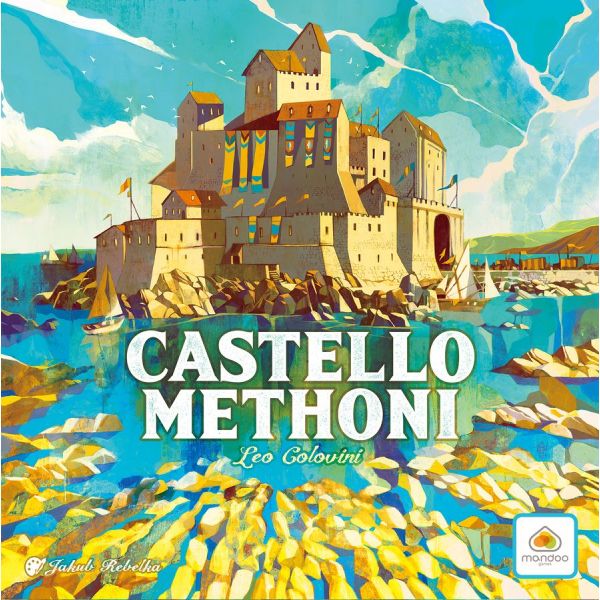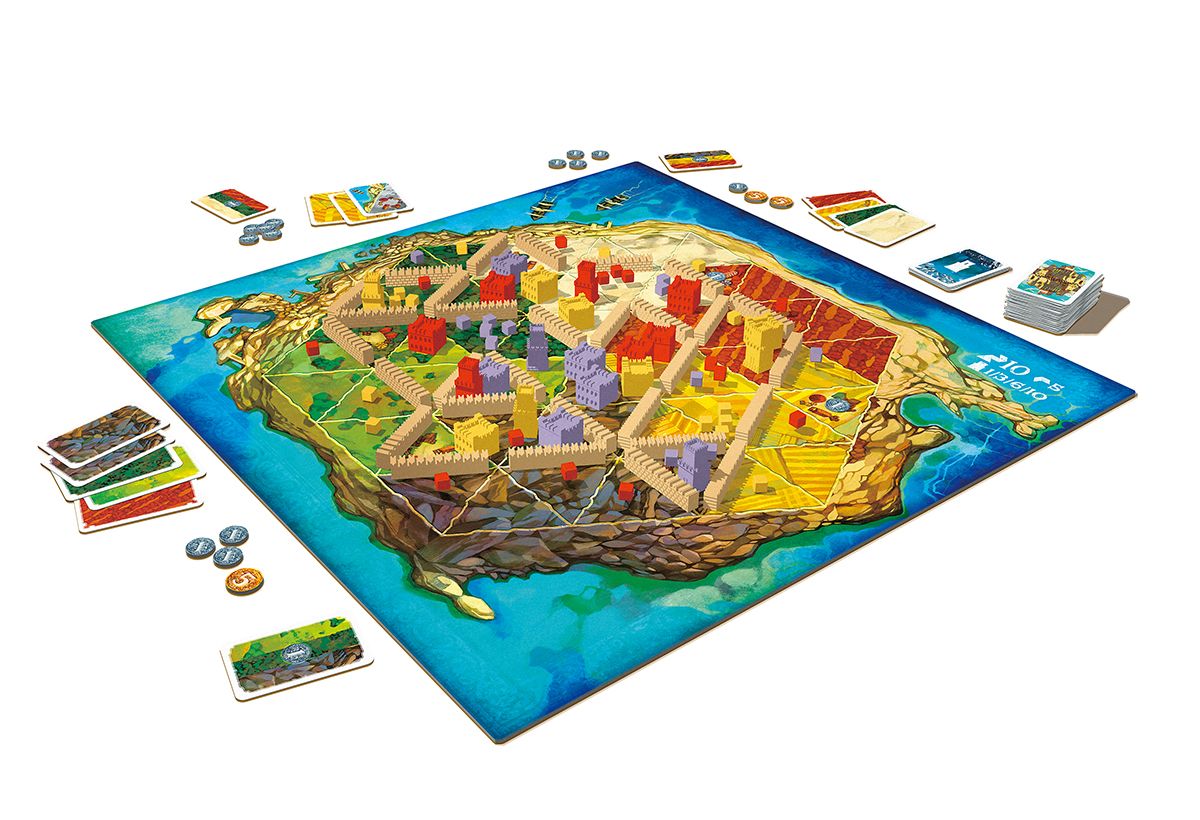Reign in the Biggest Domain in Castello Methoni

The latest from designer Leo Colovini reimplements his classic area control game, Masons, with a few new twists and turns.
Gameplay
Castello Methoni is a 3 to 5 player game in which gaining the most land within walled domains will lead to the clearest victory path. Players begin with a set of colored houses, villas, and towers and a hand of five cards, each representing one of the six land areas on the board as well as market and border cards. Players will also begin with a set amount of ducats (the game’s currency) depending on the player count and an objective card, which will outline a particular land area players will want to have within their domains at the end of the game.
Players will have two actions available to them during the course of their turn: build or trade. Building is central to the game. Players will play one of the cards from their hands, which corresponds to a land area, market, or border. They will place one of their houses on one side of the wall and choose an adjacent player to place one of their houses on the other side.
The second action is to trade for two ducats by playing a market card or land card that matches an activated market. Activated markets occur once three walls have been placed around a market tile. With two actions per turn, players may build or trade twice or do one of each action before ending their turn. After their two actions, players will draw back up (if necessary) so that they have five cards in hand.
Play continues with players laying down walls to create domains. Domains are completed walled areas. Once a player has created a domain, they may place a tower in the enclosed area and pay one ducat for each land area within the domain. For example, if a player enclosed a domain that has two land areas, it will cost two ducats to place their tower to claim the domain. Players will also pay one ducat to each house an opposing player has in the domain. Players may not enclose a domain if they are unable to pay its cost to complete.
As domains are formed, if any player has three houses within a finished domain, they become villas. These allow houses to be freed up for further placement as the game continues, but will still earn players money as domains are claimed.
Once a domain is completed next to another finished domain, a player may choose to annex the adjacent domain(s) by paying two ducats per land area within the annexed domain, one ducat per house or five ducats per villa to opponents, and remove one of the walls to connect the adjacent domains.
The game ends once all walls are gone from the group supply. Points are scored: three points for each land area within a player’s domain(s), one point for each land area that matches the objective card, and one point per unspent ducat. Bonus points are awarded to the player with the largest domain (10 points) and the second biggest domain (5 points), with ties awarding all qualifying players with the highest point total. Points are also awarded on an increasing scale for how many towers a player has placed during the game. The players with the most points wins the game.

Review
Castello Methoni takes a simple concept — area control — and delivers it with just enough strategy that it becomes something more than just a game concerned with grabbing parcels of land. Managing one’s wealth is key, not only to being able to build and annex domains, but also to scoring potential victory points. Therefore, players will have to decide whether spending a stack of ducats to create the largest domain is worth the expenditure.
Early on, market areas will not be in play because they are not within domains. As the game progresses and they become integrated into expanding domains, their importance becomes magnified. Towers in domains with markets grant two ducats per market at the start of the controlling player’s turn. This can accumulate wealth quickly, but it can also be nothing more than operating costs that go away quickly if a player is chasing big domains. Balancing one’s domains with one’s fortune is central to the gameplay.
However, such mathematical gymnastics do not make Castello Methoni an overtly complex game. It’s very often a game of sizing up the board and taking what the cards and buildings allow. The number of walls is limited by player count. Likewise, the number of houses, villas, and towers each player has is finite. There are times when players may find they have no more houses to be placed, and spread so thin they are stuck without the ability to pair three houses together to form villas to then return their limited supply of houses back to them. Ensuring houses and villas are also placed in areas where they can earn ducats (or save players from paying out to other players during domain annexation) is key.
Again, there’s a lot to manage and control within Castello Methoni and it’s likely the big play someone is sizing up never happens because they never get the cards to make it happen, or another player beats them to the punch. But Castello Methoni does not punish any player for the luck of the land cards being drawn with the payouts that will likely occur as other players annex domains and pay out a small ducat fortune to do so. This alleviates any cutthroat tactics in the game as well, because it’s likely if one player does well on their turn, at least one other player is going to benefit from this outcome. In this way, Castello Methoni is an area control and resource management game that pays it forward with far more kindness than animosity.
This is why Castello Methoni is a great casual game for players who squirm at the thought at skirmish games or more aggressive area control games. While it works better in the 3-4 player range in allowing most everyone to benefit from the moves of others, even at the 5 player count no one’s getting completely shut out from the action. However, it would be nice to see villas and houses in domains do more than just be potential earners for one or two turns — or at least offer a variant for some advanced strategy that still appeals to its casual base player.
Colovini’s slight changes and updates to the original concept of Masons, along with bright and colorful artwork from Jakub Rebelka, will make this a great introduction to area control and resource management for families and casual players alike.
Pros: Easy to pick up and play, multiple players can benefit from big turns, good introduction to basic area control and resource management mechanics, quality components
Cons: Needs at least three players to play, houses and villas could provide further functions




